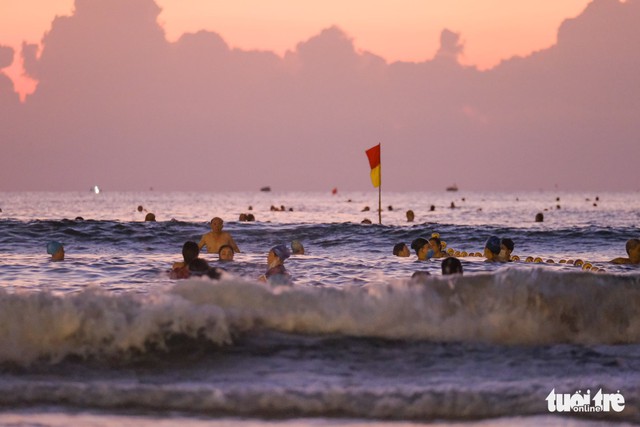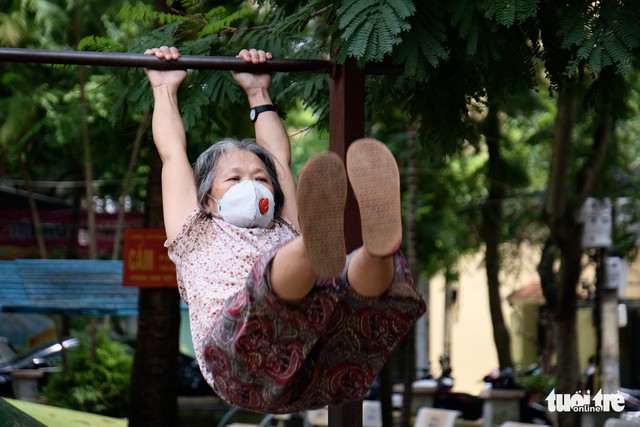
People jog in a park in District 1, Ho Chi Minh City. Photo: Duyen Phan / Tuoi Tre
They are there to dance, meditate, and connect. The iconic ritual of morning exercise in Vietnam is something to behold culturally—but does it have more meaning than we see on the surface?
I am the last person who can claim to be an expert on anything relating to this cultural practice. I am rarely up at 5:00 am, and if I am, it’s usually to take on some bicycle adventure where I have little time to even consider the community around me.
But I am an observer. And today, as I sit and take in the groups of ladies coming together, I realize this is so much more than exercise—it is a purpose for life.
Within 100 meters of my apartment in Binh Thanh District stand three separate complexes. Walking around, I noticed at least eight different groups of women partaking in various rituals—but all had one thing in common: connection.
Near my apartment were the dancers. With a small, old music player that had seen better days, the leading lady played a beat-filled track that may have come from some K-Pop group back in the 1990s. I’m sure she had it on a CD, of all things. And the ladies bounced and bopped in their own way to this obviously familiar tune.
As I crossed the street, I came across the 'Massagers'—by far the most amusing group. Around 20 ladies lined up and took turns massaging each other. The poor ladies at the end only got 50 percent of the value, but they were all smiling and having fun.
Just next door, by the waterway that separates the apartment from a local university, I came across the meditators. This group of ladies was focused on mindfulness.
Soft and relaxing music played as they stood on a small patch of grass with their shoes off. And this is important, as part of this ritual is about connecting to the earth in a bustling city that’s largely devoid of nature.
With precision and poise, these women slowly and gently followed their routine, blocking out the background noise of cars and motorbikes rushing to get to work. They made an impossible task seem easy, never missing a beat, their minds totally in focus and in the moment.
Other groups scattered around the complexes each had slight variations of these activities.
But it was the one smaller group on the far side of the park that most caught my attention.
This group of ladies—maybe only ten or so—came together like all the others. For 15 minutes, they did a little dance, similar to step aerobics, and then it was straight to the café.
The time they spent exercising was barely enough to warm up. As soon as they got into the rhythm, it all stopped, and they headed straight to their regular café for a morning coffee. Clearly, this wasn’t about exercise. Morning meetings like this are about connection and community. They’re about inclusion and feeling wanted.
In Western culture, we have gyms and boot camp classes. We pay money to go and get our daily exercise. Then we shower, get in our car, and go to work.
However, in Vietnam it’s not about money, for these are not pay-for-service classes. It’s not about getting fit, as these groups never do anything at 100 percent. It’s about a balanced, healthy lifestyle.

People swim at a beach in Da Nang City in the early morning in this file photo by Tuoi Tre.
Without these groups, there would be no reason to get out of bed at 5:00 am. The commitment to each other starts their day with purpose. This ultimately extends their quality of life and brings mental health and physical benefits to everyone involved.
It is also about connection. Having a community to be part of is important. Without these groups, isolation and loneliness—especially among post-retirement-aged people—could lead to an increased risk of early death. It’s all about caring for yourself and caring for others at the same time.
However, don’t think these groups are limited to retired Vietnamese ladies only. On a recent visit to Landmark 81, the tallest building in Ho Chi Minh City and Vietnam, one early Sunday morning, I came across a group dancing beside the Saigon River. Included in the group was a foreign man who appeared well-versed in the routine of the cha-cha-style dancing they were doing—and he was very good.
As I passed him walking back from the park, it was clear this wasn’t a casual dance for him. He was covered in sweat, and it was obvious he used this time as a serious workout.
Variations of these groups happen all over the country. In Hanoi, I stood in awe as elderly men and women gathered beside Hoan Kiem Lake in the Old Quarter on a cool afternoon and did a Tai Chi-type routine. And last year, I once saw an energetic group came together on Cam Ranh Beach to bash out a very energetic Zumba routine, the morning sea breeze in their faces.

Hanoi resident Le Thi Phong performs a hanging leg raise on a bar at the E Yard on Van Chuong Street in Dong Da District, Hanoi. Photo: Nguyen Bao / Tuoi Tre
I don’t know where it came from or how it became so popular. All I know is that it’s incredibly special to see people connecting with people in this wonderful part of Vietnamese culture. It’s wonderful that people put others before themselves. And no matter what happens in life, they live with purpose and happiness—because they know they are part of a community.
That is the Vietnam that I love.



Max: 1500 characters
There are no comments yet. Be the first to comment.